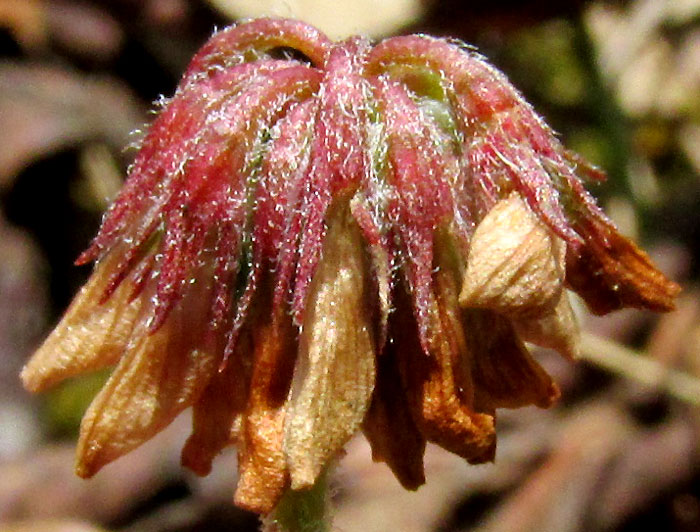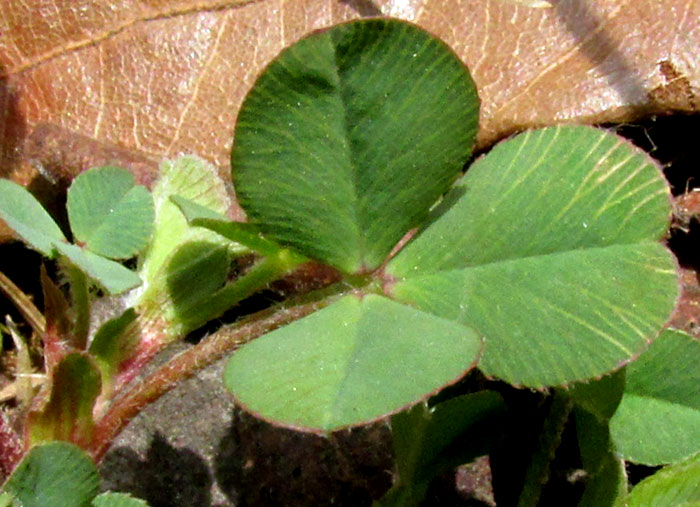Excerpts from Jim Conrad's
Naturalist Newsletter
entry from field notes dated July 2, 2022, taken on the eastern lower slope of Cerro de la Cruz, at an elevation of ~2700m (~8850 ft), just south of the community of El Pinar, Amealco de Bonfil, Querétaro, MÉXICO, (~N20.17°, ~W100.17°)
AZTEC CLOVER

In an open spot at the edge of the oak forest covering Cerro de la Cruz's lower slope, the above clover had managed to appear, despite the rainy season already being a month late after an extra long, especially rainless dry season. Most people can recognize clovers, especially because they're often common in lawns and along roads, and their compound leaves divided into three leaflets are so easy to identify. However, about 300 species of clover, genus Trifolium, are recognized, and many of those species don't fit people's stereotypes. The above one, though, should.

The above flowering head either is past its peak of flowering, or is suffering from the lack of rain, the flowers are drooping, and its corollas are turning from white to brown. The trifoliate leaves, however, look healthy:

Note that at the base of the petiole, where it attaches to the stem, two green, earlike modified leaves called stipules arise, one on each side of the petiole attachment. This species produces relatively large and distinct stipules, so here's a better look:

When the leaves are young, they arise from between the stipules which wrap around them like protective hands. The stipules protect the young leaves' sensitive tissue from damage of various kinds. Stipules come in many sizes and shapes, and are a feature throughout the Bean Family, to which clovers belong, though many other plant families produce them, too. Often stipules fall off once their protective service is no longer needed, but this clover's look like they may hang around awhile, even possessing green chlorophyll so they can photosynthesize and help feed the plant.
In our area, if you have a clover that's of this small size, with hairy vegetative parts, and the three leaflets fairly broad, with at least the middle leaflet somewhat notched at its tip, you have Aztec Clover, TRIFOLIUM AMABILE.
Aztec Clover is distributed from northern Mexico south deep into South America, mostly occurring in moist mountain meadows, in oak and pine forests, often on exposed banks, at elevations of 1600-3400m (5200-11,200ft).
Aztec Clover is yet another species first scientifically collected by Humboldt and Bonpland during their visit to Mexico in 1803 and 1804. Sometimes their notes are very sketchy about where the plants were collected, but for this plant they wrote in Latin, Crescit in pratis prope Toluccam, meaning "It grows in the meadows near Tolucca," Toluca being a big town just over the mountains west of Mexico City.
The online Atlas de las Plantas de la Medicina Tradicional Mexicana informs us that to encourage the secretion of milk in nursing women, the whole plant can be soaked in water, with the resulting infusion taken on an empty stomach for two or three days.
Otherwise, clovers are famous for their mycorrhizal root nodules, which release a nutrient form of nitrogen into the soil, not only benefiting themselves but also the surrounding biotic community as a whole. And of course all kinds of grazing mammals love to eat clover.
Our little Aztec Clover is a good citizen wherever it grows.
Entry from field notes dated September 3, 2023, taken in Los Mármoles National Park in the Eastern Sierra Madre mountains, Hidalgo state, MÉXICO; oak-pine forested mountain peak about 3km west of Puerto de Piedra, on road branched off the road between Trancas {on maps designated "Morelos (Trancas)"} and Nicolás Flores; limestone bedrock; elevation ~2,600m (~8,500); N20.816°, W99.214°
FLOWERING

Freshly opened flowers are shown above, and below there's a close-up of two flowers in the head:
